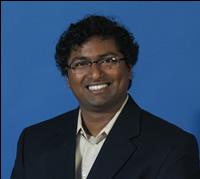Saibal Mukhopadhyay is a recipient of Intel’s 2019 Outstanding Researcher Award. He is one of seven researchers from around the world to receive this award who work in the areas of quantum computing, artificial intelligence, and other emerging innovative technologies.
Mukhopadhyay is the Joseph M. Pettit Professor in the Georgia Tech School of Electrical and Computer Engineering (ECE), and he leads the Gigascale Reliable Energy-Efficient Nanosystem (GREEN) Lab. He received the Intel Outstanding Researcher Award for his collaborative research on “Integrated Voltage Regulators for Power Attack Protection of Encryption Engines.”
Modern system-on-chips (SoCs) ranging from high performance processors to smart phones to Internet-of-Things devices include on-chip encryption circuits. An encrypted message is secure as long as the key is a secret. But whenever an encryption engine operates, it dissipates power and generates electromagnetic emissions that depends on the value of the secret key. An adversary can “listen” to these signals and find out the secret key through statistical analysis. This problem is known as side channel analysis, and it is a critical threat to modern microelectronics. The traditional approaches to reduce this information leakage often increases energy consumption or slows down the circuit.
In this collaborative project with Intel, Arvind Singh and Monodeep Kar, both former Ph.D. students in the GREEN Lab, and Mukhopadhyay have explored a new way to address this problem. The integrated voltage regulators are an essential component to improve energy-efficiency of modern SoCs. The GREEN lab team has demonstrated security-aware voltage regulators that, along with assisting in energy-management, also reduce information leakage from encryption engines. Their design makes it thousands (3000X) of times harder to attack a chip but adds minimal overhead.
The project has led to multiple articles in top circuit conferences and journals, including the International Solid-State Circuits Conference, IEEE Journal of Solid-State Circuits, and IEEE Transactions on Power Electronics; many tutorials and invited presentations; and two Ph.D. theses. The work was also covered in IEEE Spectrum.
